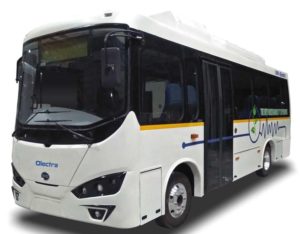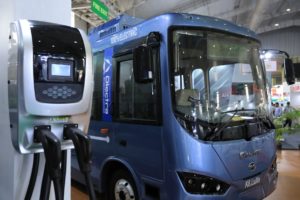
Olectra Greentech, formerly known as Goldstone Infratech, is part of the highly diversified Goldstone Group. Olectra Greentech, a major supplier of composite insulators, has ventured into manufacturing of electric buses in collaboration with the globally renowned BYD group. We have N. Nagasatyam, Executive Director, Olectra Greentech Ltd, in this exclusive exchange with T&D India, discussing various aspects of the company’s electric buses’ vertical. Nagasatyam is confident that with increased adoption, electric buses will the most cost-effective and most eco-friendly mode of urban public transport.
What inspired the diversification into manufacturing of electric buses?
This is a known fact that reserves of crude oil or natural gas are running out at a fast pace. An eco-friendly and much feasible alternate is electricity, which should be properly utilized. Since Olectra-BYD, formerly Goldstone Infratech, was already in the business of electrical products, it brought an apt opportunity to utilize our deep understanding of the electrical industry. Hence, we made this strategic and visionary move to manufacturing electric buses.
What was the rationale behind choosing BYD Auto as your collaborator? Please also describe the nature of this partnership. Is this only a technical collaboration?
BYD has been known for innovation and we are also pioneers in our business verticals. Taking this tradition forward, we ventured into the electric vehicle segment three years ago, with a focus on public transport vehicles. The strategic partnership with BYD is significant since the battery is a key component in any electric vehicle and, as you are aware, BYD is the world’s largest supplier of rechargeable batteries. Besides, they are specialists in IT, automobiles and new energy. We have installed fireproof lithium iron phosphate batteries in our bus models eBuzz K6, eBuzz K7 and eBuzz K9. These use LiFePo4 as cathode material, ensuring longer lifetime and better power density. This is the safest technology due to chemical and thermal stability. This was possible due to BYD’s strong competence in the field. We are looking forward to our partnership with BYD and will continue to collectively offer innovative products to consumers.
Olectra-BYD buses are 100 per cent “Made in India”
Do you have established manufacturing or assembling facilities of electric buses in India, as yet? What is the eventual plan?
Olectra-BYD has a plant at Jadcherla, near Hyderabad, Telangana, where we have been manufacturing electric buses. The plant has a capacity to manufacture 2,100 electric buses per year. We have plans to scale up our manufacturing capacity to around 5,000 buses per year by 2021.
We are also exploring for opportunities to expand our manufacturing capacities to cater to the increasing demand for the e-buses in the market.
Olectra Greentech has recently won orders for supplying nearly 300 electric buses to various state governments. What is the current order book, and by when are you expected to fulfil the same?
 We have a strong order book as we won the bids to supply 290 buses to various state transport undertakings (STUs). Olectra-BYD has emerged as frontrunner as we received the order for supplying the largest number of electric buses to the STUs. In addition to this, we have also supplied 25 electric buses to Himachal Roadways Transport Corporation. The supply to these STUs have been initiated as our buses – eBuzz K6 (7 meter), eBuzz K7 (9m) and eBuzz K9 (12m) have also started plying on various routes in Hyderabad, Mumbai and Rohtang-Manali-Kullu. Recently, we received an expression of interest from Uttarakhand Transport Corporation to ply 500 electric buses in the northern state.
We have a strong order book as we won the bids to supply 290 buses to various state transport undertakings (STUs). Olectra-BYD has emerged as frontrunner as we received the order for supplying the largest number of electric buses to the STUs. In addition to this, we have also supplied 25 electric buses to Himachal Roadways Transport Corporation. The supply to these STUs have been initiated as our buses – eBuzz K6 (7 meter), eBuzz K7 (9m) and eBuzz K9 (12m) have also started plying on various routes in Hyderabad, Mumbai and Rohtang-Manali-Kullu. Recently, we received an expression of interest from Uttarakhand Transport Corporation to ply 500 electric buses in the northern state.
Were these imported from BYD?
Olectra-BYD buses are 100 per cent “Made in India” — indigenously designed and manufactured in our plant at Jadcherla, Telangana.
The government is promoting e-mobility through various programmes, including “FAME”. As an electric bus manufacturer, what kind of government support are you seeking?
In the initial period of moving from traditional fuel run vehicles to electric vehicles, any government subsidies or financial assistance would certainly assist in the faster adoption. However, as the ecosystem develops, people won’t need such assistances as the cost of owning and running would come down. The e-vehicles would turn out much cheaper than the existing petrol, diesel or CNG vehicles. With the increasing local manufacturing of the electric vehicles at lower costs it will be easier for the public to buy e-vehicles. Beyond the initial phase, we don’t feel there is any government support needed as the industry is matured enough to handle such issues.
In the long run, even if an electric bus is bought at current prices, the overall cost is much lower than that of a diesel bus.
Tell us about the efficiency of electric buses, vis-à-vis diesel and CNG buses.
Electric buses have significantly low operating costs at approximately Rs.8 per km as compared to approximately Rs.24 per km for a diesel bus. In the case of CNG bus also, the operating cost comes to Rs.14 per km. Overall, due to the operational efficiency, electric buses will prevail over all other options.
The cost of an electric bus is several times that of a conventional diesel bus. How challenging is this for penetration of electric buses in India, especially considering that there are various forms of ownership of buses – government, private, PPP, etc?
 As adoption increases, costs would certainly come down. In fact, in the longer run, even if an electric bus is bought at current prices, the overall cost is much lower than that of a diesel bus. This is because the running costs are almost one-third in the case of an electric bus.
As adoption increases, costs would certainly come down. In fact, in the longer run, even if an electric bus is bought at current prices, the overall cost is much lower than that of a diesel bus. This is because the running costs are almost one-third in the case of an electric bus.
Manufacturers like Olectra-BYD are also offering the option of “joint ownership” to the state transport undertakings. STUs, instead of purchasing the bus, can pay the operator on per-running km and the maintenance is also taken care of by the operator. This way, STUs don’t have to make the capital investments but reap the benefits of lower operating costs, providing comfort to passengers and also contribute in reducing carbon footprint.
India is aspiring for 100 per cent domestic production of e-vehicles. What challenges do you foresee?
The only deterrents at this point of time are the relatively higher cost of buying an e-vehicle and limited charging facilities. Like any other transformation, the ecosystem will also be strengthened in the coming period. As the number of e-vehicles grows and their demand increases, prices would certainly come down as manufacturers would be able to benefit from economies of scale. Stakeholders will have to make the arrangements of charging stations or battery swapping options.
There has been much R&D in advancing the performance of buses to drive the longest possible on a single charge.
What is your overall outlook on e-mobility, particularly electric buses, in India? What are your key business development plans in the medium term?
There is no doubt that electric vehicles are going to be the future, not only from the environmental perspective but also due to the growing prominence of alternate energy sources. Policymakers too are pushing for a move to electric vehicles.
Our strategic partnership with BYD is an example of our vision to bring and support electric mobility in India. Our long-term plan is to manufacture 5,000 electric buses per year in India by end of financial year 2021.
Tell us in brief about the recent technological advancements in electric buses, especially in developed countries?
Ever since electric buses have been introduced, there has been very good response. Technology is developing fast and is appreciated globally. But significantly, there were few challenges; for instance, driving longer distances on a single charge. There has been much R&D in advancing the performance of buses to drive the longest possible on a single charge. There are companies who claim to drive for about 1700 km per charge. Olectra-BYD has got the technology to deploy the longer-range electric buses as per customers’ requirement.
In India, we understand that most of the so-called electric buses are in fact “hybrid” buses. What are the various types of electric buses available in India, and what is the current penetration of pure electric buses in India?
Hybrid buses have played a decent role in the Indian public transportation. But technically understanding; Hybrid buses need the support liquid fuel (diesel) to run on the roads. By which they are not known to be 100% electric buses. Whereas the electric busses do not need any liquid fuel’s support and completely rely on the electricity and that’s the reason we call it 100% electric bus.
The types of buses can be classified into various aspects based on the seating capacity, battery, torque etc.


